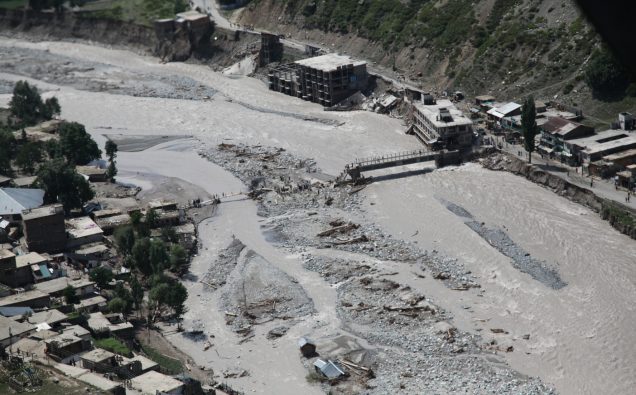
A file photo shows a washed-out bridge, damaged from flooding, is shown in Pakistan Aug. 5, 2010 Credit:DoD by Staff Sgt. Horace Murray/Wikipedia
A spate of disasters due to a mix of extreme weather and climate change effects made 2017 as the costliest year, damaging lives and livelihoods in monsoon flooding, droughts and hurricanes several parts of the globe, a new report says.
“The start of 2018 has continued where 2017 left off – with extreme weather claiming lives and destroying livelihoods,” said Petteri Taalas, Secretary-General of the World Meteorological Organization (WMO).
The latest edition of the WMO Statement on the State of the Global Climate in 2017 documents that disasters ranging from flooding to droughts hit hard with implications for economic development, food security, health and migration.
The disaster losses from weather and climate-related events spiraled to $320 billion – the largest annual total on record.
According to the UN, the statement confirmed that last year was one of the three warmest on record, and the warmest not influenced by an El Niño event.
The report also examines other long-term indicators of climate change, such as increasing carbon dioxide concentrations, sea level rise, shrinking sea ice and ocean heat.“The Arctic experienced unusually high temperatures, whilst densely populated areas in the northern hemisphere were gripped by bitter cold and damaging winter storms. Australia and Argentina suffered extreme heatwaves, whilst drought continued in Kenya and Somalia, and the South African city of Cape Town struggled with acute water shortages,” Mr. Taalas reflected on 2017.
The North Atlantic hurricane season was not only the costliest ever for the United States, but it also eradicated decades of small Caribbean islands’ development gains.
“Since the inaugural Statement on the State of the Global Climate, in 1993, scientific understanding of our complex climate system has progressed rapidly,” Taalas says.
“This includes our ability to document the occurrence of extreme weather and climate events, the degree to which they can be attributed to human influences, and the correlation of climate change with epidemics and vector-borne diseases,” he continued.
The report, compiled by WMO with input from national meteorological services and UN partners, details that 2017 global mean temperatures were about 1.1 °C above pre-industrial temperatures.
It also provides detailed information to support the international agenda on disaster risk reduction, sustainable development and climate change.

Image Source: WMO
“In the past quarter of a century, atmospheric concentrations of carbon dioxide have risen from 360 parts per million to more than 400 ppm. They will remain above that level for generations to come, committing our planet to a warmer future, with more weather, climate and water extremes,” Mr. Taalas asserted.
The overall risk of heat-related illness or death has climbed steadily since 1980, with around 30 per cent of the world’s population now living in climatic conditions that deliver potentially deadly temperatures at least 20 days a year.
Between November 2016 to December 2017, 892,000 drought-related displacements were recorded.
“Now more than ever, we need to be weather-ready, climate-smart and water-wise,” Taalas warns as the world faces an uncertain fate of the Paris Climate Agreement.





![By Cyclonebiskit [Public domain], via Wikimedia Commons](https://www.viewsnews.net/wp-content/uploads/2018/03/2017-Atlantic-hurricane-season-summary-Map.jpg)













